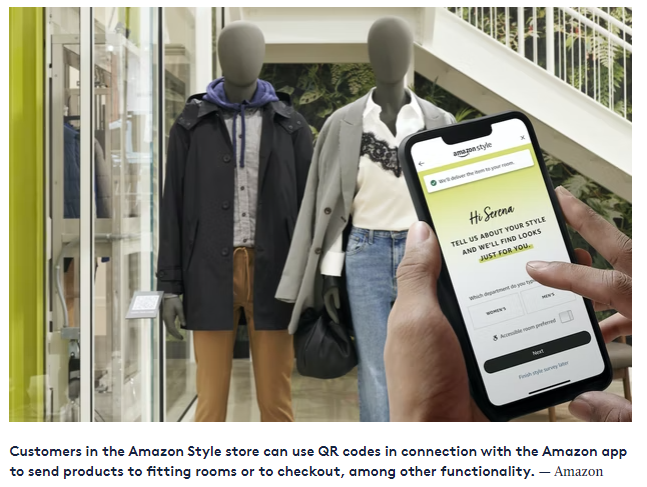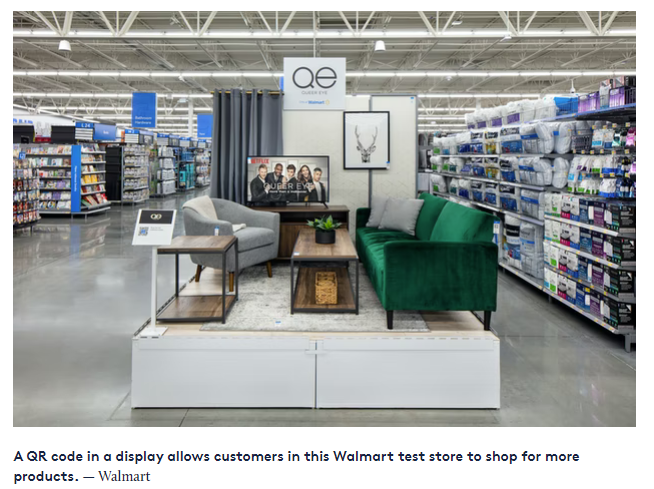Brands leverage the pandemic-fueled popularity of the scannable barcodes to enable contactless consumer payments and a more experiential shopping journey.

Why it matters:
Scanning QR codes as a contactless way to access restaurant menus became routine almost overnight for many consumers at the start of the pandemic.
Marketers have since capitalized on that momentum to elevate QR codes from a niche tool that links to basic content into a much more versatile platform to engage with consumers and provide new shopping experiences.
QR (short for quick response) codes have become an integral element of so called “stores of the future” for companies such as Walmart and Amazon, and are increasingly being deployed in new ways that have been embraced by both marketers and consumers, said Maryann Moschides, chief marketing officer and general manager at Scanbuy, which worked with Pepsi on its QR code campaign during the Super Bowl halftime show this year.
The key to successful marketing using QR codes is to offer something interesting or useful to consumers, she explained. She cited the company’s work with Burger King to offer a free Whopper with another purchase via the BK app to consumers who scanned a QR code in a TV commercial.
“You have to give them something,” Moschides said. “You have to inspire them with something to do, or to earn, or play a game — something that's worth their time.”
Offering a QR code as a means to enter a contest or some type of gamified promotion generally generates a strong response, she said.
In one recent example of a QR-code-activated contest, Molson Coors showcased the partnership between its Miller Lite brand and Colombian rapper Jose Alvaro Osorio Balvin, a.k.a. J Balvin. Consumers could scan a QR code on specially designed Miller Lite packaging for a chance to win a “virtual meet and greet” with the artist, plus $500.
Measuring the return on investment for QR codes involves comparing a brand’s cost per customer acquisition, which can vary widely, depending on the company and the industry, Moschides said. To optimize the effectiveness of QR codes, marketers need to ensure they are well-placed and include a visible call to action, she said.
Kellogg’s director of experience: Tapping QR codes to deliver ‘something more’ than a website
Simply providing a QR code on packaging to offer more in-depth information about products also remains a top use case for QR codes, Moschides said. Offerings links to information, whether about ingredients, sustainability, sourcing, or other content, has grown increasingly commonplace, she said.
“We've seen the trajectory of that usage by brands going up significantly, as well as more engagement by consumers,” Moschides said.
QR codes on Kellogg’s cereal packaging help the company create more rewarding experiences for consumers, Kevin Sidell, director of experience planning, cereal brands, at Kellogg Co., told CO—.
The company activated QR-code-enabled, connected features in late 2019 on its Special K and Frosted Flakes cereal packages, shortly before the pandemic began, he said. Customers were able to scan QR codes on packaging for access to content ranging from timely articles to promotions to augmented reality experiences.
“Our goal was to create a valuable experience for consumers, delivering something more than what they would experience through a traditional website and ideally return to engage with over time,” Sidell said.
Since then, Kellogg’s has added QR codes to Froot Loops and other products.
Kellogg works with Scanbuy to tally the number of scans consumers make on its packaging. It gathers data on the total number of users, volume of repeat visitors versus new visitors, time spent on the experience, page views, and other content interactions, which all provide valuable insights about consumer interests.
“The real value is what happens after the scan and interactions with our content that we see with the experiences as measured via web analytics,” said Sidell.
Kellogg Co. continues to experiment with different approaches to using QR codes, and its strategies will continue to evolve, he said.
Scanbuy’s 2021 fourth quarter Trend Report showed 35% growth in unique customers engaging with QR codes compared with the first quarter, 21.8% growth in QR code usage, and 21.2% growth in QR code product packaging engagement.
The top mobile engagement experiences were custom content, app downloads, brand promotions, and product information.
A recent report from eMarketer projected that the number of U.S. smartphone users scanning a QR code will increase from 83.4 million in 2022 to 99.5 million in 2025
“Marketers have significant opportunities to leverage QR codes in areas such as shopping centers, billboards, interactive TV, interactive screens, and nonfungible tokens,” eMarketer concluded.
Amazon and Walmart: Leveraging QR codes to serve up detailed info on products, services — and ring up sales
QR codes have also shown up at pop-up stores as a vehicle for both conveying information about products and e-commerce ordering and are increasingly being used alongside traditional barcodes, or as a replacement to barcodes, said Moschides.
At Walmart’s incubator store in Springdale, Arkansas, QR codes and digital screens “create opportunities for digital exploration,” said Alvis Washington, vice president, marketing, store design, innovation and experience, in a recent blog post.
“Using our stores as an initial display of the great variety of products and brands, we can communicate to customers the vast range of products and services Walmart offers online through the strategic use of QR codes and digital screens,” he said.
For example, in the store’s pet products department, customers can scan QR codes to find additional product options not displayed in the department, learn about other services such as Walmart’s pet insurance, or order products to be delivered to their homes.
Amazon is using QR codes in its recently opened brick-and-mortar Amazon Style apparel store in a similar manner. Using the Amazon Shopping app, customers scan an item’s QR code to browse sizes, colors, customer ratings, and other product details. Then they can have an item sent to a fitting room or directly to the checkout counter for purchase.

MOSCOT eyewear: Using QR codes to activate virtual-try-on experiences
Boutique eyewear retailer MOSCOT, meanwhile, recently launched a QR code campaign with technology partner Vertebrae in which customers can scan QR codes to activate virtual try-on experiences at the company’s New York City store, as well as online. Conversion rates have increased up to 135%, with revenue per visit increases of “upwards of 174%” for shoppers who engage with the 3D and virtual try-on experiences, according to Vertebrae.
While viewing restaurant menus has been one of the key gateways for consumers to become familiar with QR codes, their use is expanding to provide increasing functionality for restaurant operators and their customers, said Sam Zietz, CEO of GRUBBRR, which provides self-ordering technologies for the restaurant industry.
Among the ways QR codes are emerging as restaurant tools include enabling tableside ordering, whereby customers can scan a QR code that takes them to an online ordering platform where they can order directly from their phone, he said. QR codes can also be used as a form of contactless payment and to leave a review about the quality of service at a restaurant.
“QR codes are going to continue to rise in popularity,” Zietz told CO—. “Not only do they eliminate the need for paper menus, but they also allow customers to pay from their phone, ensuring a completely contactless experience that frees the waitstaff from having to process payments.”
CO— aims to bring you inspiration from leading respected experts. However, before making any business decision, you should consult a professional who can advise you based on your individual situation.
Follow us on Instagram for more expert tips & business owners’ stories.To stay on top of all the news impacting your small business, go here for all of our latest small business news and updates.
Click here to view the original posting
CO—is committed to helping you start, run and grow your small business. Learn more about the benefits of small business membership in the U.S. Chamber of Commerce, here.
Kezzler Expands Industry Leadership with Acquisition of Scanbuy
Neutronian Announces That Scanbuy Has Earned Its Data Quality Certification